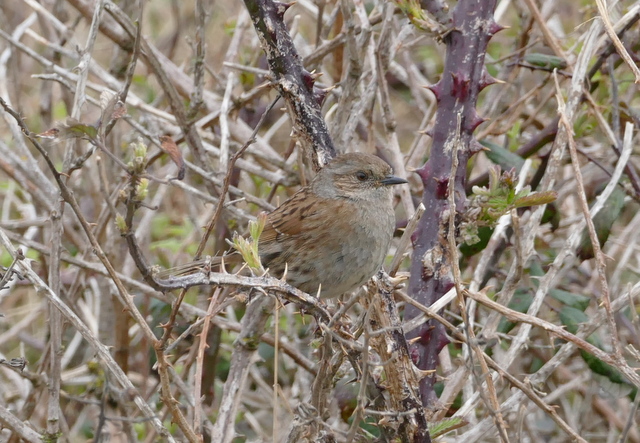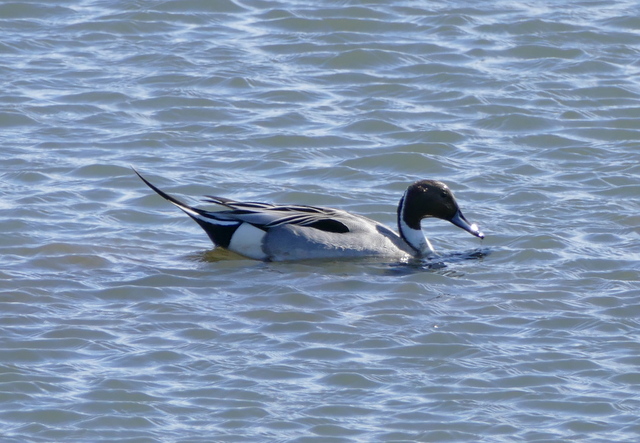An early Spring Tour in North Norfolk today. We really wanted to see some migrants and catch up with some of the regular birds along the coast.
We started off heading to Holme to explore the dunes, looking for grounded migrants. It was spitting with rain as we drove up, but we thought we might get away with it. We had a look round the paddocks – there were lots of Chiffchaffs singing, but not much else of note. We turned to walk back towards the dunes, hoping to have a look for Ring Ouzels, but we could already see the sky darkening. We only got a little further before it started to rain harder, so we made a quick dash back to the car. Time for a change of plan.
 Dunnock – a portrait of one of our commoner birds
Dunnock – a portrait of one of our commoner birds
We had intended to go to Titchwell anyway today, but we just headed there earlier than planned. It was back to spitting with rain again when we arrived, so we set off to have a look round the car parks. However, we hadn’t got far when the heavens opened and we had a short downpour. We sheltered in the trees and thankfully it was short-lived. There was not much around the car park once the rain eased – a Bullfinch called from the hedge. But a scan of the fields beyond produced a single lingering Pink-footed Goose in amongst the throng of feral Greylags and Canadas. Then a call alerted us to a Little Ringed Plover flying overhead, which diverted and seemed to head over towards the Freshmarsh. A nice early migrant.
We walked out onto the reserve. As the rain had swept in, the wind had picked up and it was now very blustery along the main path. We had a quick look at the Thornham grazing marsh pool, still devoid of water and fairly devoid of birds today. The reedbed pool, however, provided us our first pair of Red-crested Pochard today, as well as Common Pochard and Tufted Duck.
 Red-crested Pochard – several pairs around the reserve today
Red-crested Pochard – several pairs around the reserve today
We took shelter in Island Hide to have a look at the Freshmarsh. One of the first birds we picked up was the Little Ringed Plover, on one of the islands with a couple of Ringed Plover. It was a good opportunity to see the two species side-by-side. A couple of Avocets flew over and started to feed in front of the hide, but the water was still very deep where they landed – it was hard to tell whether they were standing on the bottom or swimming!
 Avocet – trying to feed in the deep & choppy water
Avocet – trying to feed in the deep & choppy water
There was a good selection of ducks on view, including Shelduck, lots of Gadwall, still several Teal but fewer than in recent weeks, Mallard and Shoveler. Some of the Shoveler were feeding right in front of the hide, so we got a great look at them – particularly their oversized bills! A pair of Red-crested Pochard were asleep on one of the islands.
 Shoveler – check out the size of that bill!
Shoveler – check out the size of that bill!
We walked round to Parrinder Hide during a lull in the rain. As we walked up towards the hide, we could see a small crowd looking out along the top of the bank beyond. Just beyond them was a little group of Yellow Wagtails. They looked stunning, bright yellow, at least 8 of them feeding along the path. They were obviously on their way somewhere, but had stopped off for a short while, possibly encouraged to land by the rain. We watched them working their way along the path towards us – they got quite close at one point. Then suddenly they took off and disappeared, continuing on their way to wherever they were headed.

 Yellow Wagtails – 8+ dropped in to feed for a few minutes today
Yellow Wagtails – 8+ dropped in to feed for a few minutes today
There were plenty of other waders to see as well. A little group of three Bar-tailed Godwits were sleeping, tucked down behind one of the islands, proving a challenge to spot the differences from the more plentiful Black-tailed Godwits. There were several Ruff, both larger males and the smaller female Reeves. Some of the male Ruff were looking smart, getting more advanced in their moult into summer plumage. On the Volunteer Marsh we added Curlew and Grey Plover, as well as getting nice close-up views of some more Black-tailed Godwits.
 Black-tailed Godwit – getting more of its brighter orange summer plumage
Black-tailed Godwit – getting more of its brighter orange summer plumage
There wasn’t much to see out on the Tidal Pools today. A smart pair of Pintail spent most of the time with their heads under the water. It was a bit too windy on the beach – the sea was very choppy and the tide was in. There were several Sanderling running in and out of the waves. We managed to pick up a Great Crested Grebe and a couple of Common Scoter out on the sea. Then we decided it would be better to get out of the wind, so we headed back.
 Pintail – a pair were on the Tidal Pools again today
Pintail – a pair were on the Tidal Pools again today
We walked back via the Meadow Trail. It was less windy in the trees, and by now the rain had blown over and it was blue skies and sunshine overhead. A couple of Willow Warblers were singing from deep in the sallows. Eventually we saw one, flicking around low down in the trees. There were several Chiffchaffs singing as well, and we finally got a better look at one of those. A male Blackcap was not singing, but we did still manage to pick him out, moving more slowly around amongst the branches.
Fen Hide was fairly quiet, though more birds than usual – a Mute Swan, a drake Pochard, a drake Mallard and a Coot! Patsy’s Reedbed similarly struggled to add anything new for the day’s list. We did get good views of at least four Marsh Harriers over the reedbed though.
After lunch, we drove back along the coast to Holkham. It was still very windy – if anything the wind had strengthened further. So we headed for the shelter of the trees. It was not calm, even along the path on the inland side of the pines, and as a consequence it seemed a bit quiet bird-wise. No shortage of Chiffchaffs – every few yards, another one seemed to be singing – and another Willow Warbler singing too. But the tits and Goldcrests seemed to be sheltering in the trees. We only heard a single Treecreeper as we walked along.
We had gone some way when we decided to have a look in a more sheltered, sunny corner of the trees. We were really hoping to see a Goldcrest or two, but instead we heard the distinctive song of a Firecrest. It was distant, some way back in the trees, but we followed the sound and eventually found it flitting around the trunk of an ivy-covered pine tree. We could see its black and white face stripes and bronzey neck-side patch. A good bird to see at this time of year here.
Feeling chuffed with our find, we headed on to the Joe Jordan hide. We had not even climbed up the steps when we spotted the first Spoonbills, feeding on the pool below the trees. As we sat in the hide, birds were back and forth between the trees and the pool pretty much constantly. A couple of them returned to the trees carrying nest material. We sat and watched them for some time and there were lots of other things to look at, too – lots of Marsh Harriers hanging in the wind, plus Grey Herons, Little Egrets and Cormorants coming and going from the colony.
 Spoonbill – its nuchal crest blowing around in the strong wind
Spoonbill – its nuchal crest blowing around in the strong wind
With time getting on, we decided to explore the dunes. Having been thwarted by the rain this morning in our attempt to find some migrants at Holme, it seemed like another good place to look. However, we had a good look round amongst the bushes but it seemed pretty devoid of life. We flushed a single Song Thrush, presumably a migrant. Otherwise, it was just lots of Meadow Pipits and a few Linnets. There had been surprisingly few hirundines moving today, but we did finally get a single Swallow flying wets through the dunes.
Having already walked some way, we decided to give it one last push and head for the next dune ridge before turning for home. The flat area before the ridge was sheltered from the wind and there was a very big flock of Linnets on the ground in the lee. Duly encouraged, we stopped and scanned the flock and there nearby was a cracking male Wheatear. We had a good look at it, the mostly monochrome grey/black/white plumage, with its black bandit mask, and this one had quite a strong orangey wash on the breast. While we were watching it a female Wheatear appeared on the dunes next to the male.
 Wheatear – a pair were in the dunes this afternoon
Wheatear – a pair were in the dunes this afternoon
That was pretty good, a nice migrant to see up on the coast, but perhaps not what we were hoping for. Then there was a real commotion. Two dogs were running around in the dunes, completely out of control. We could hear their owner shouting at them and whistling from miles away, but the dogs were not interested – they were having too much fun chasing Rabbits. They were in the Nature Reserve as well, though thankfully at this time of year there were not too many birds already nesting. The Linnets scattered, the Wheatears flew off to the higher dunes.
We were just about to start cursing the dogs and their owner when two thrush-sized black birds flew up from the dunes as well. Two Ring Ouzels, just what we had been looking for, and they landed, one of them in a bush. Unfortunately we didn’t have time to get the scope on them before the ongoing commotion flushed them again, as the dogs continued to run riot. The Ring Ouzels flew across in front of us, two males, flashing the bright white crescents on their breasts as they went.
We had a quick skirt round the dunes but we couldn’t find them again – presumably they had headed further west towards Gun Hill. We were out of time, so we walked back. What a great way to end – two Ring Ouzels, the classic early spring migrant here on the coast, on their way north to the moors and mountainsides.
















